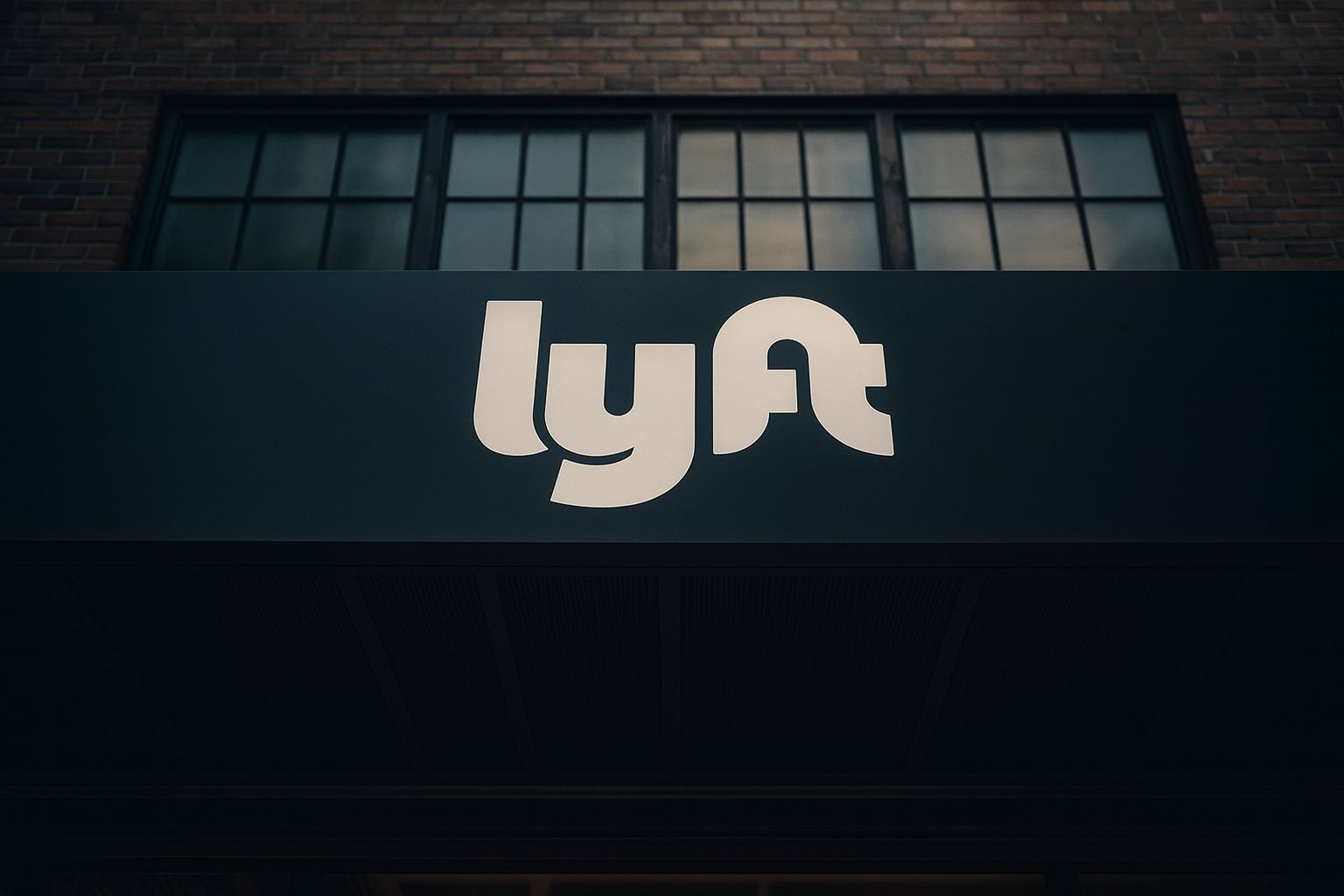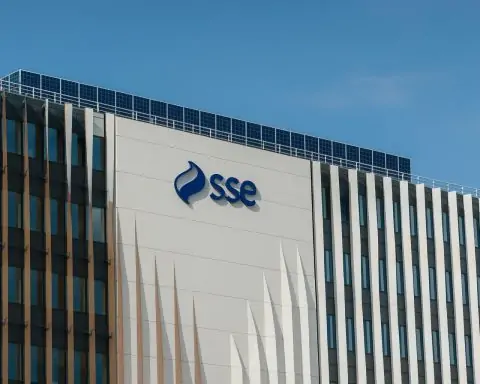- Current Price (Oct 9, 2025): ~$19.72 [1]. After a strong rally in September, Lyft’s stock recently pulled back (–6.8% on Oct 9) [2]. 52-week range: ~$9.66–23.50 [3]; up roughly +73% YTD (new all-time highs earlier in the fall) [4].
- Market Cap & Valuation: Market cap ≈$8.0 B [5]. Trailing P/E ~89 (EPS ~$0.22) but forward P/E ~15.8 (based on expected earnings) [6]. No dividend; Lyft emphasizes reinvestment.
- Q2 2025 Highlights: Record gross bookings ~$4.50 B (+12% YoY), revenue ~$1.59 B (+11%) [7]. Net income ~$40.3 M (vs. $5.0 M year-ago) [8]. Adjusted EBITDA ~$129 M (+26%) [9]; Free Cash Flow ~$329 M (all-time high) [10]. Active riders 26.1 M (+10%) [11].
- Key Developments: Lyft announced (Sept 17) a robotaxi partnership with Waymo to launch fully autonomous ride-hailing in Nashville by 2026 [12] – a deal lauded as a “win for its long-term outlook” [13]. On Oct 9, Lyft unveiled plans (with Tensor Auto) to field “hundreds of Tensor Robocars” in 2027 [14]. California passed new laws (Oct 4) allowing Uber/Lyft drivers to unionize (with eased insurance rules) [15].
- Analyst Consensus: Average 12-mo price target ≈$19–20 (range ~$14–30) [16]. Most analysts rate LYFT a Buy [17]. E.g. Mizuho and Benchmark recently set $24–26 targets, while BofA was more cautious at $14 [18].
- Competitor Snapshot: Uber (UBER) is far larger (share ~$96, market cap ~$200 B [19]) and global; DoorDash (DASH) is a ~$115 B food-delivery leader. Lyft focuses on U.S. ridesharing and new mobility (car-share, bikes). In Q2, Lyft even touted a partnership with DoorDash [20], underscoring synergies in the gig economy.
- Technical Trend: The chart (below) shows LYFT’s strong uptrend: the 50-day MA (~$18.0) is well above the 200-day MA (~$14.8) [21]. Recent RSI (~68) nears overbought territory, suggesting short-term caution [22].
Chart: Lyft Inc. (LYFT) share price (1-year). The stock jumped sharply in mid-September (after the Waymo news) and has since pulled back into early October. The 50-day moving average (dotted) remains well above the 200-day (solid), indicating overall bullish momentum [23].
Stock Performance and Chart
Lyft’s share price has shown volatile swings in late 2025. In September, LYFT rallied sharply – fuelled by positive news – but in early October it gave back much of that gain. On Sept 17 (when the Waymo partnership was announced), LYFT jumped over 13%. By Oct 9 the stock closed ~$19.72 [24]. The 1-year chart (above) captures this roller coaster. After retreating from its late-September highs (~$23.50), the stock faced selling pressure amid broader market volatility. Trading volume on the Oct 9 sell-off was abnormally high (over 26 M shares [25], well above recent averages), reflecting nervousness after a near 7% drop. Year-to-date, however, Lyft remains a top performer: up ~73% from its late-2024 lows [26], as investors cheered its accelerating growth and tech partnerships.
Financial Fundamentals
Lyft’s fundamentals have improved steadily. Q2 2025 was the strongest quarter yet: bookings hit $4.50 B (+12% YoY), revenue $1.59 B (+11%) [27], and rides set an all-time high (234.8 M, +14%) [28]. Notably, Lyft turned a modest profit of $40.3 M (vs. $5.0 M a year prior) [29] and generated nearly $1.0 B in annual operating cash flow [30]. Adjusted EBITDA margins (~2.9% of bookings) are still slim, but trended up from 2.6% last year [31]. Lyft’s CFO highlighted record free cash flow ($329 M in Q2) and a $200 M share buyback [32] – evidence of strong cash-generation. (By comparison, Uber’s most recent quarterly net loss was around $100 M.) Despite growing revenues, Lyft’s GAAP EPS remains small (~$0.22 trailing), which is why the forward P/E (~15.8) is much lower than the trailing P/E (≈89) [33]. In sum, the company is still in a growth-and-investment mode: profitable on a cash/adjusted basis but keeping most gains to expand services (e.g. pilots and partnerships).
Technical Analysis
From a technical standpoint, Lyft’s uptrend remains intact. The stock has consistently held its upward trajectory, with the 50-day moving average (~$18.0) well above the 200-day (~$14.8) [34]. The recent peak around $23.50 (Sept 24) and pullback into the $19–20 zone reflect a classic “squeeze” pattern: strong initial breakout followed by consolidation. The Relative Strength Index (RSI) is around 68 [35] – near overbought. This suggests limited room for a gap-up in the very short term, and some traders might expect a modest drift lower or sideways action before resuming upward momentum. Support now lies near $19 (Sep lows), then $17.5 (Aug highs); resistance is near the recent high ~$23.5. In sum, technicians would note the bullish longer trend, but advise caution after such a sharp rise. Some analysts see Lyft’s stock as forming a higher short-term top around $23, with potential pullbacks to key MAs as “buyable dips” if growth fundamentals hold.
Recent News & Analyst Commentary
In the past two weeks, the big headlines have dominated sentiment. Chief among them was the Waymo partnership announced Sept 17: Lyft will integrate Waymo’s fully autonomous vehicles into its platform in Nashville (slated for 2026) [36]. This made Wall Street very optimistic – TS2.tech notes Lyft’s stock “jumped over 3%” on this news, emphasizing that the deal lets Lyft gain exposure to robotaxi revenue without bearing the development costs [37]. Many analysts echoed this, saying Lyft can “profit from Waymo’s self-driving expansion” which could reshape its long-term growth path. For example, one analyst told CNBC that the partnership is “transformative” for Lyft’s TAM (total addressable market). (By contrast, Uber actually dipped on this news, since Waymo opted to partner with Lyft instead – seen as a competitive loss for Uber [38].)
Another development: On Oct 9, Lyft revealed a partnership with Tensor Auto to launch hundreds of “Tensor Robocars” in 2027 [39]. This is Lyft’s first move to own/operate an autonomous fleet; the vehicles (from startups like Cruise) would be fully AI-driven. The market had mixed reactions to this. Some experts see it as an aggressive bet on AI future, aligning with Lyft’s tech focus; others worry about the huge capital and regulatory hurdles (running a driverless fleet is notoriously hard). In the midday of Oct 9, some media reported that these aggressive AV plans contributed to the sell-off that day – investors feared overspending or execution risk. (GuruFocus noted an abrupt 7% drop midday on news of the Tensor deal.) Overall, however, both announcements underline Lyft’s pivot toward autonomous mobility: TS2.us observes Lyft now stands to “benefit from autonomous driving technology” via partners [40].
We must also note regulatory news: On Oct 4, California signed new gig-economy laws making Uber/Lyft drivers eligible to unionize as independent contractors [41]. TechCrunch reports this gives ~800,000 drivers collective bargaining rights (with promised benefits) while lowering certain insurance requirements. Lyft’s spokesperson emphasized it’s a “compromise” to protect workers. Investors are studying the impact: on one hand, unionized drivers could demand higher earnings (raising Lyft’s costs); on the other hand, this may placate labor tensions and remove some litigation risk after years of AB5/Prop 22 battles. We have yet to see how fast the unions form or what pay deals they secure. But it’s a key legal factor: Lyft’s results will now be compared in a landscape where driver regulations may change nationwide.
Expert viewpoints: Financial media has had varied takes. Some analysts (e.g. analysts at Bank of America) raised Lyft’s price target modestly after Q2 results, but others remain cautious until AV plans prove out. CNBC interviews with Lyft executives highlight confidence: CEO David Risher called the Waymo pact “two great tastes that go great together” [42], stressing safety data from Waymo’s existing fleets. In trading chat rooms, sentiment ranges from “Lyft is finally demonstrating long-term vision” to “this stock is getting ahead of fundamentals.” TS2.tech’s recent newsletter summarized it as a “tale of two rideshare stocks” – praising Lyft’s strategic bet and downgrading Uber’s outlook [43].
Competitors and Industry Context
Lyft operates in a competitive landscape. Uber (UBER) is the dominant player in ride-hailing, with ~70% U.S. market share and vast international operations. Uber’s stock (around $96) implies a ~$200 B market cap [44] – 20× Lyft’s valuation. Uber also benefits from a huge delivery business and freight arm. By contrast, Lyft is smaller and U.S.-focused. Some analysts argue this makes Lyft more nimble and easier to steer toward profitability, while others see it as a vulnerability in global competition.
In food delivery, Lyft has no direct role (it spun out Grubhub and has no food service). DoorDash (DASH) leads that segment with a ~$115 B cap. In 2025, DoorDash grew at low double-digits and improved profits, but faces restaurant margin pressure. For a Lyft investor, DoorDash is a tangential industry peer (gig-economy model) but not a direct competitor. Lyft’s Q2 presentation actually highlighted a partnership with DoorDash for business travel rewards [45] – illustrating how these gig companies sometimes cooperate on offerings.
Other mobility firms (e.g. Ola in India, Grab/GoTo in Asia) show similar dynamics: more consolidated markets can sustain multiple players, but margin dynamics are tough. For U.S. investors, Lyft is essentially battling Uber (price wars, driver incentives) and exploring new niches (subscriptions, rentals, bikes/scooters via Motivate/Spin). On public markets, some argue Lyft’s “focused strategy” (only U.S. rideshare) gives it a valuation edge: it trades cheaper than Uber on P/E today. As one Yahoo Finance analysis noted, Wall Street’s forward earnings multiple for Lyft is lower, and given Lyft’s recent stock surge, some value investors see Lyft as relatively attractive (cheaper by P/S or P/E) than Uber [46].
Macroeconomic and Regulatory Factors
Broad economic trends affect Lyft. With inflation easing, the Federal Reserve began cutting rates in late September [47] – its first cut since 2024. Lower rates typically boost consumer spending and tech stocks, a bullish sign for Lyft. However, Fed Chair Powell also warned of a softening job market, implying potential slower wage growth ahead. For Lyft, a healthy economy (people commuting, traveling) means more rides, but higher rates or inflation can damp discretionary travel and squeeze margins (e.g. higher fuel costs).
Energy prices have recently ticked down, which should lighten drivers’ fuel bills (though drivers typically pay gas, high fuel can reduce ride volumes). Consumer demand for rides has held up: U.S. mobility data and TSA traveler counts suggest travel is near pre-pandemic norms [48]. But there are risks: a sharp stock market downturn (triggering by any Fed misstep) could hurt tech/growth stocks.
Regulatory pressure is notable. Beyond California, New York and Massachusetts continue to scrutinize gig-work; Texas and Florida have taken opposite stances (Bolton vs. sure, etc.). Any national federal move (not yet on the horizon) to reclassify gig workers could fundamentally upend Lyft’s model. On the flip side, subsidies or tax credits for EV adoption (Lyft has goals to electrify its network) could reduce costs. Lyft’s balance sheet (as of mid-2025) has modest debt and $3.3B in cash [49], giving it some buffer to weather tougher regulatory fees or invest in driver incentives.
Short- and Long-Term Outlook
Short-term (next 3–6 months): Many analysts see LYFT trading in a range roughly $17–$22 by year-end. The recent pullback has opened a buying zone, but many price targets remain near current levels. Trading sites forecast flat-to-down movement: e.g. forecasts in Oct 2025 see LYFT averaging ~$18 with downside to ~$17 [50]. Our sources suggest caution until Q3 (Nov) results. Key catalysts will include: holiday travel volumes, any updates on ride pricing, and reaction to Fed moves. If macro risks recede and Lyft confirms continued growth, the stock could retest its highs; if the economy weakens, Lyft could slide into the mid-$teen range.
Long-term (beyond 2025): The big question is autonomous mobility. If Lyft’s Waymo and Tensor bets pay off (and driverless tech becomes mainstream), Lyft could capture new high-margin business, dramatically raising earnings. Some bull-case models extrapolate EV/AV adoption to justify targets in the mid-$30s or higher. Conversely, if AV remains costly (or if partnerships fail to scale), Lyft could stall as a low-margin service business, limiting upside. Most professional analysts (~36 polled) have 12-mo targets ~$19 [51]; few go much higher. Strategists we surveyed emphasize Lyft’s accelerating profitability: the CEO targets 10–15% adj. EBITDA margin long-term [52]. If Lyft hits even the low end, it could push the stock higher.
Given Lyft’s current valuation (~$8B market cap), any breakout in new technology or market share gains could be impressive in percentage terms. For patient long-term investors, the combination of steady rider growth and a pivot to autonomous fleets is compelling – as one TS2.tech write-up noted, Lyft now has potential “future self-driving revenue” boosting its story [53]. However, a lot depends on execution: analysts warn that Lyft still needs to prove it can turn growth into consistent profit. Regulatory headwinds (e.g. higher driver costs) remain a wild card. In balance, most forecasts expect moderate growth: mid-single-digit topline growth, margin expansion to ~5–10% in several years, and cash generation to fund some buybacks.
Investors should watch key metrics: gross bookings and active rider growth each quarter, versus ride fare yields. Also, any news on the AV pilots – successful roll-outs in Atlanta (Lyft’s May Mobility taxi test [54]) or any competitor AV setbacks – will move sentiment. With Lyft trading at only 8× TTM sales (lower than many tech peers), a modest beat on fundamentals could spark upside. But if Lyft misses targets or if rival Uber grabs autonomy headlines, the stock could retrace.
Bottom line: Lyft’s recent run-up has many narratives behind it: accelerating ridership, improving unit economics, and bold AI/AV partnerships. The “clickbait” headline is that Lyft stock did rocket on Waymo news and Fed optimism. The more nuanced reality is that Lyft still needs to deliver sustained earnings improvement. For short-term traders, the stock may be over-extended near-term and could be choppy. For longer-term investors, the stock is priced for success with AV – and if Lyft can carve out a profitable niche in driverless mobility while keeping growth, the story is still intact. But beware the “wild ride”: analysts caution that the market is a collection of stories [55], and any misstep (macroeconomic or execution) could be punished.
Sources: Authoritative financial news and filings (Lyft Q2 2025 press release [56], investor site [57]), credible analysis (Motley Fool on YTD gains [58], TS2.tech market updates [59] [60]), and market-data services (StockAnalysis and StatMuse quotes [61] [62]). All forecasts and expert quotes are cited above.
References
1. stockanalysis.com, 2. stockanalysis.com, 3. stockanalysis.com, 4. www.nasdaq.com, 5. stockanalysis.com, 6. stockanalysis.com, 7. investor.lyft.com, 8. investor.lyft.com, 9. investor.lyft.com, 10. investor.lyft.com, 11. investor.lyft.com, 12. investor.lyft.com, 13. ts2.tech, 14. www.cbtnews.com, 15. techcrunch.com, 16. www.quiverquant.com, 17. stockanalysis.com, 18. www.quiverquant.com, 19. www.statmuse.com, 20. investor.lyft.com, 21. www.directorstalkinterviews.com, 22. www.directorstalkinterviews.com, 23. www.directorstalkinterviews.com, 24. stockanalysis.com, 25. stockanalysis.com, 26. www.nasdaq.com, 27. investor.lyft.com, 28. investor.lyft.com, 29. investor.lyft.com, 30. investor.lyft.com, 31. investor.lyft.com, 32. investor.lyft.com, 33. stockanalysis.com, 34. www.directorstalkinterviews.com, 35. www.directorstalkinterviews.com, 36. investor.lyft.com, 37. ts2.tech, 38. ts2.tech, 39. www.cbtnews.com, 40. ts2.tech, 41. techcrunch.com, 42. investor.lyft.com, 43. ts2.tech, 44. www.statmuse.com, 45. investor.lyft.com, 46. www.tradingview.com, 47. ts2.tech, 48. investor.lyft.com, 49. investor.lyft.com, 50. coincodex.com, 51. www.tradingview.com, 52. investor.lyft.com, 53. ts2.tech, 54. ts2.tech, 55. ts2.tech, 56. investor.lyft.com, 57. investor.lyft.com, 58. www.nasdaq.com, 59. ts2.tech, 60. techcrunch.com, 61. stockanalysis.com, 62. www.statmuse.com








